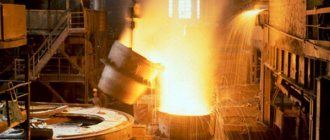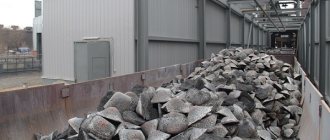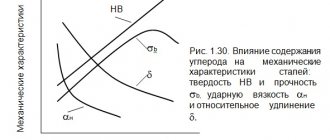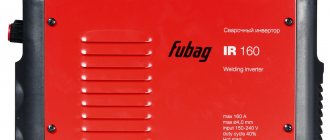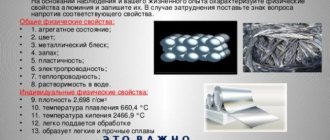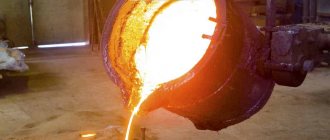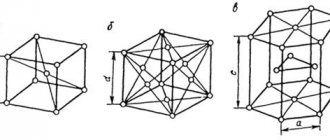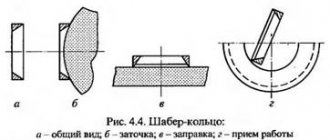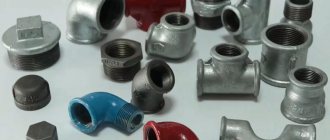In this article I will talk about the most important element of modern production of ferroalloys and cast iron, the blast furnace. It is the main equipment of a blast furnace, so I think everyone is interested in learning about the components of a blast furnace and the principle of operation.
Iron ore is used as a raw material, and the main product of blast furnace production is cast iron, which has found its application in various fields of activity: automobile production, manufacture of sanitary ware, cast iron cookware, etc.
By the way, you can call a tow truck in Almaty around the clock for your car here.
Concept of blast furnace and smelting
Modern civilization is inextricably linked with the development of production technology, which is impossible without improving the tools and materials used for their manufacture.
Among all materials of natural origin or created by man, the most significant place is occupied by ferrous metals - an alloy of iron and carbon with the presence of other elements.
Alloys containing 2–5% carbon are classified as cast iron; those containing less than 2% carbon are classified as steel. For melting metals, a special blast furnace technology is used.
Blast smelting is the process of producing cast iron from iron ore processed in blast furnaces or, as they are also called, blast furnaces.
The main materials needed in the process of such production are:
- fuel in the form of coke obtained from coal;
- iron ore, which is the direct raw material for production;
- flux – special additives made from limestone, sand, and other materials.
A blast furnace is a device for producing cast iron by reducing smelting of iron ores or concentrates.
The main equipment of a blast furnace is a blast furnace - a round shaft furnace lined with refractory masonry.
To protect the furnace casing from heat, refrigeration devices are used. The furnace casing and furnace furnace device are installed on the foundation and supported by columns.
The starting material for smelting is called charge and consists of iron ore, manganese ore, sinter, and pellets. The charge is supplied to the furnace top by skips or a belt conveyor. The skips are unloaded into the furnace through the receiving funnel. Air is supplied through air heaters, the smelting product exits through tapholes into ladles located in the lower part.
Modern blast furnaces are equipped with a centralized control and monitoring system that provides recording of instrument indicators and complex indicators of blast furnace operation - coke consumption per 1 ton of pig iron and daily blast furnace productivity in tons.
Additional fuel is used, which reduces coke consumption and the cost of cast iron. Improving the design of a blast furnace is aimed at increasing its power (volume), improving the preparation of raw materials, and introducing new progressive, high-performance technologies.
Pig iron is smelted in blast furnaces, which are a shaft furnace. The essence of the process of producing cast iron in blast furnaces is the reduction of iron oxides included in the ore with gaseous (CO, H2) and solid (C) reducing agents formed during the combustion of fuel in the furnace.
The blast furnace smelting process is continuous. Source materials (sinter, pellets, coke) are loaded into the furnace from above, and heated air and gaseous, liquid or pulverized fuel are supplied to the lower part.
Gases obtained from fuel combustion pass through the charge column and give it their thermal energy. The descending charge is heated, reduced, and then melted.
Most of the coke is burned in the lower half of the furnace, providing a source of heat, and part of the coke is spent on reducing and carburizing the iron.
A blast furnace is a powerful and highly productive unit that consumes a huge amount of materials. A modern blast furnace consumes about 20,000 tons of charge per day and produces about 12,000 tons of pig iron every day.
Minerals in iron ores
The main ore-forming iron minerals are hematite, limonite and magnetite.
Hematite is a red iron ore. Contains iron in the form of anhydrous iron oxide Fe2O3. The iron content in red iron ores is 45-65% with a small amount of harmful impurities.
Limonite is a brown iron ore. Contains iron in the form of aqueous oxides such as nFe2O3×mH2O. Brown iron ore contains 25-50% iron.
Magnetite is a magnetic iron ore. Contains iron mainly in the form of iron oxide Fe3O4, which has magnetic properties. Magnetites - the richest iron ores - contain 40-70% iron.
Components of a blast furnace
A blast furnace is a continuously operating unit consisting of the following zones:
- Hot blast.
- Melting zone (shoulders and hearth).
- FeO reduction zone (steam).
- Fe2O3 reduction zone (mine).
- Preheating zone (fire pit).
- Loading iron ore materials, limestone and coke.
- Blast gas.
- Column of iron ore materials, limestone and coke.
- Slag release.
- Production of liquid cast iron.
- Collection of waste gases.
The internal outline of the vertical section of a blast furnace is called the furnace profile.
The working space of the furnace includes:
- fire pit;
- mine;
- steam;
- shoulders;
- horn
- Koloshnik.
The upper (narrow) part of the furnace is called the top. The top has a charging apparatus for loading charge (ore, fuel, fluxes) and gas outlet pipes through which gases called blast furnace or top gases are removed from the blast furnace. The part of the furnace between the top and the steam is called the shaft.
The part of the furnace, facing upward with a truncated cone and supporting the charge in steam along with the charge and the top, is called shoulders. In this part of the furnace, there is a rather sharp reduction in the volume of loaded materials as a result of coke burnout and the formation of liquid smelting products.
- Mine.
The shaft accounts for most of the total height and volume of the furnace. The profile of the shaft, which is a truncated cone expanding towards the bottom, ensures uniform lowering and loosening of the charge materials.
The significant height of the shaft allows for thermal and chemical processing of materials by rising hot gases.
- Rasp.
This is the middle cylindrical part of the furnace working space, having the largest diameter. Steaming creates some additional increase in furnace volume and eliminates possible delays in charge materials.
- Shoulders.
This is a part of the furnace profile located below the steam chamber and is a truncated cone with its wide base facing the steam chamber. The reverse taper of the shoulders corresponds to a decrease in the volume of melted materials during the formation of cast iron and slag.
- Horn.
The lower part of the furnace, which has the shape of a cylinder, in which the smelting products—liquid iron and slag—accumulate, is called the forge. The furnace has holes radially located at equal distances from each other (10-16, depending on the size of the blast furnace).
Double-walled red copper, bronze or aluminum pipes are inserted into these holes. These holes are called tuyeres.
Hot air heated in air heaters (coopers) is blown through the tuyeres by a fan or blowing machines. The tuyeres are cooled by water circulating in the space between the pipe walls.
Additional elements of the blast furnace
During the work process, auxiliary devices and mechanisms are required to ensure high-quality melting of cast iron. Devices for lifting and loading raw materials into the furnace are necessary.
A blast furnace requires constant maintenance, especially when producing slag and cast iron. For this purpose, foundry yards are equipped with overhead cranes.
Heating of air for furnace operation, high melting temperature with less air is provided by air heaters. For example, to a furnace with a useful volume of 2000 m³, such equipment must supply 3800 m³ of air per minute, the temperature of which is 1200 degrees.
The steam generated by air entering the air heater must be constantly moist. The value of this indicator is regulated using an automatic system.
Compressed air, which is necessary for burning fuel, enters the furnace thanks to air blowers. Its pressure at the top of modern furnaces reaches 25 MPa. The blast furnace gas is purified using a gas purifier.
Historical reference
The appearance of domain production itself is attributed to gray. 14th century D. p. arose as a result of the evolution of the cheese-making process of obtaining a plastic low-carbon iron mass (the so-called rock iron) directly from iron ore by reducing it in low cheese-making furnaces (a pit lined with refractory clay, or a stone hearth), which worked on natural soil. traction. The fuel was charcoal. After the end of the process, the cheese furnace was dismantled, the resulting metal was extracted and special. hammers were processed into a workpiece or product. A gradual increase in the height of cheese furnaces and the power of blowers contributed to an increase in the process temperature, which led to an increase in the solubility of carbon in the metal and a decrease in its melting temperature. Thus, along with the criticism, unwanted metal was obtained. the product in a liquid state (cast iron), and the cheese furnace turned into a vertical shaft furnace, called. “high furnace” (German: Hochofen, French: Haut fourneau) or blast furnace (from the Slavic word “dmenie” - blast, English: blast furnace). The first blast furnaces intended only for the production of cast iron appeared in Europe in the middle. 14th century, in Russia - approx. 1630 (near Tula). In the Urals, the first cast iron was produced in 1701. When the furnace height exceeded 16–18 m, the charcoal used lost its strength, crumbled into small particles and thereby made it impossible for the normal movement of gases upward through the charge layer. An important factor that determined the growth of pig iron production and, accordingly, the increase in the size and productivity of the blast furnace, was the invention of A. Derby (see Derby) in 1735 of a method for producing coal coke, which became the main method. diesel fuel. The use of a steam blower was of great importance for the development of diesel production (1762, I. I. Polzunov; 1769, J. Watt); an air heater with a fireproof nozzle (1857, E. Cowper); fluxed sinter (1945–50, Magnitogorsk Iron and Steel Works); technologies with injection of natural gas and oxygen into the furnace (1958–70; Zaporizhstal, Novolipetsk plant), etc. This means. Fatherland contributed to the development of D. metallurgists M. A. Pavlov, M. K. Kurako, I. P. Bardin and others.
Purpose of a blast furnace and operating principle
The production of pig iron in the blast furnace is an important branch of the iron and steel industry.
This work requires not only the need to use special equipment, but also careful adherence to certain technologies.
Smelting is carried out in a blast furnace from waste rocks and ore matter.
The ore substance can be red, brown, spar, magnetic iron ore or manganese ores.
Iron reduction is one of the main stages of cast iron production.
As a result of this process, the iron becomes hard. Next, it is dipped into steam, which promotes the dissolution of carbon in the iron. Thus, cast iron is formed. It is in the hot part of the furnace that the cast iron itself begins to melt, slowly flowing down to the lower part.
The operating principle of a blast furnace depends on the type of this bulky device.
There are coke and charcoal ovens.
The former work on coke, the latter, respectively, on charcoal.
The shaft furnace is designed for continuous operation. The shape of this equipment is two cones, folded with wide sides at the base. Between these cones there is a part of the furnace that has a cylindrical shape - steam.
The operating principle of a blast furnace is expressed in several physical and chemical operations. The presence of these operations is determined by the temperature region of the furnace itself and the load of material.
In general, the following processes can be distinguished:
- the process of decomposition of limestone, resulting in the formation of carbonic anhydride and calcium oxide;
- restoration of iron and other elements;
- carburization of iron;
- metal smelting;
- the formation and melting of slag;
- fuel combustion and others.
A blast furnace air heater is a device in which air is preheated. This air is then fed into the furnace.
Early equipment for smelting cast iron did not have such an element as an air heater. The development of the device has made it possible to significantly reduce fuel costs.
The operating principle of a blast furnace is based on complex physical and chemical processes.
The following operations are distinguished:
- fuel combustion;
- iron recovery;
- decomposition of limestone into calcium oxide and carbonic anhydride;
- saturation of iron with carbon;
- metal smelting;
- slag melting, etc.
In the most general sense, blast furnace smelting is the production of pig iron from iron ore raw materials.
The main materials with which cast iron can be smelted are:
- fuel - coke;
- iron ore is the raw material from which cast iron is smelted;
- flux – special additives made from sand, limestone and some other materials.
The charge enters the furnace in the form of small fused pieces - pellets or agglomerates. The ore substance can be manganese ore or various variations of iron ore. The raw materials are poured into the furnace in layers, alternating with layers of flux and coke.
Slag floats to the surface of hot cast iron. Impurities are drained off before the liquid metal hardens.
The supply of raw materials, like the operation of the furnace, must be continuous. The consistency of the process is ensured by special conveyors. Getting into the furnace through the described elements, the charge goes through a number of technological processes.
Burning coke gives the required temperature, which should not fall below 2000 degrees. Combustion promotes the combination of oxygen and coal. At the same time, carbon dioxide is formed. Under the influence of high temperature, the latter becomes carbon monoxide. Thanks to this, iron is restored.
Cast iron becomes cast iron after the iron passes through molten coke. For the result to become possible, the iron must be saturated with carbon. Cast irons include alloys containing 2-5% carbon.
After the finished metal has accumulated in the forge, it is released through tapholes. The slag is first released through the upper hole, and then the cast iron is released through the lower hole. The latter is drained through channels into buckets and sent for subsequent processing.
Basic physical and chemical processes
: fuel combustion, will restore. and gas-dynamic processes, heat exchange, cast iron formation, slag formation. Basic a quantity of coke is lowered into the hearth and burned together with additionally injected fuel (gaseous, liquid or dust) at the tuyeres; in a simplified form, the overall combustion process is reduced to the reaction: 2C+O2=2CO. Gases with a temperature of 1600–2300 °C, containing 35–45% CO, 1–12% H2 and 45–65% N2, rising, heat the descending charge (the temperature of the gases leaving the furnace is 100–300 °C) . Part of the coke is spent on the reduction of Fe2O3 and Fe3O4 entering the blast furnace (contained in iron ore materials) according to the reactions:
3Fe2O3+CO=2Fe3O4+CO2
Fe3O4+CO=3FeO+CO2
FeO+CO=Fe+CO2
FeO+C=Fe+CO
In addition to iron oxides, the oxides of Ni, Cu, As, and P are almost completely reduced and the corresponding elements are transferred to cast iron; Zinc oxide is also completely reduced, zinc sublimes and is deposited in the pores of the lining, causing its partial destruction. Elements that form stronger compounds with oxygen than Fe are partially reduced from oxides (V – 75–90%, Mn – 40–80%, Si and Ti in small quantities) or not reduced at all (Al, Mg and Ca). S (harmful impurity) enters the blast furnace mainly. with coke and passes mostly into slag (in the form of FeS, MnS, CaS), to a small extent (up to 5%) into cast iron (FeS) and into the gas phase. The resulting iron absorbs C in the solid state, which helps to reduce the melting temperature of the carburized product and more completely saturate it with carbon. The C content in cast iron depends on the temperature of the cast iron, its composition, etc. Slag consists of oxides: SiO2, Al2O3, CaO, MgO (90–95% in total), FeO (0.3–1.0%).
D. p. is an environmentally friendly, high-tech energy- and resource-saving process; energy consumption is 16–17 GJ/t of cast iron, and taking into account the use of secondary energy resources – 12–13 GJ/t of cast iron; the consumption of the most scarce component of the charge (coal coke) is 300–350 kg/t of cast iron, while 100–150 kg of coke substitutes are used.
Blast furnace products
The products of blast furnace smelting are:
- cast iron;
- slag;
- blast furnace (top) gas.
Cast iron
Pig iron is the main product of blast furnace production, and slag and blast furnace gas are by-products.
Cast irons smelted in blast furnaces, depending on the method of further use, are divided into three groups:
- conversion materials used for processing into steel;
- foundries intended for producing cast iron castings in mechanical engineering;
- special (ferroalloys) used for deoxidation of steel in steelmaking.
Cast iron is a multicomponent alloy of iron with carbon, manganese, silicon, phosphorus and sulfur.
Cast iron also contains trace amounts of hydrogen, nitrogen and oxygen. Alloyed cast iron can contain chromium, nickel, vanadium, tungsten and titanium, the amount of which depends on the composition of the ores being smelted.
Pig iron is intended for processing into steel.
This type of cast iron is characterized by the fact that the carbon in it (2.2-4%) is in a chemically bound state.
The fracture surface of cast iron is white.
Depending on the composition and method of processing, there are:
- open hearth cast iron containing phosphorus from 0.15 to 0.30% and sulfur up to 0.07%;
- Bessemer, containing phosphorus 0.07% and sulfur up to 0.069%;
- Tomasovsky, containing phosphorus 1.6% and sulfur up to 0.08%.
Pig iron is divided into three types:
- Conversion coke (grades M1, M2, M3, B1, B2).
- Conversion coke phosphorous (MF1, MF2, MF3).
- High-quality pigment coke (PVK1, PVK2, PVK3).
After leaving the blast furnace, cast iron is poured into pigs and sent cold to machine-building plants, where it is melted again in special cupola furnaces to cast machine parts.
Foundry coke iron is smelted in seven grades: LK1-LK7.
Each grade is divided into three groups based on manganese content, five classes based on phosphorus content and five categories based on sulfur content.
Phosphorous cast irons.
A special group consists of phosphorous cast irons containing up to 2% P; depending on the phosphorus content, various technologies are used for converting such cast irons into steel.
Foundry cast irons.
This type of cast iron is intended for the production of cast products in iron smelting shops. A characteristic feature of these cast irons is their high silicon content (2.75 - 3.75% Si), and in some cases phosphorus. This is explained by the fact that these elements give the molten cast iron high fluid mobility or the ability to fill the casting mold well.
Foundry cast iron is used after remelting in machine-building plants to produce shaped castings.
Foundry cast iron is used for the manufacture of cast products:
- pipes;
- radiators;
- water fittings;
- stanine;
- blocks;
- gears, etc.
Such cast iron has a gray color when fractured. In it, part of the carbon is in a free state, in the form of graphite. Gray cast iron usually contains 1.25-4.25% silicon, 2.5-4% carbon, 0.5-1.3% manganese, 0.1-1.2% phosphorus and a small amount of sulfur.
Manganese gives cast iron its hardness and brittleness.
Silicon, on the contrary, reduces the hardness of cast iron, making castings made from such cast iron easy to machine.
Phosphorus makes cast iron meltable and fills thin sections of molds well.
Castings made of cast iron containing a high amount of phosphorus resist abrasion well, but at the same time have increased fragility.
Sulfur gives cast iron a dense melting point and reduces its mechanical properties.
Special cast irons (ferroalloys).
These are iron alloys with a high content of silicon, manganese and other elements, used as deoxidizers or additives in steelmaking and iron foundries.
These include:
- ferromanganese (70 – 75% Mn and up to 2% Si);
- ferrosilicon (9 – 13% Si and up to 3% Mn);
- mirror cast iron (10 – 15% Mn and up to 2% Si).
In recent years, the smelting of ferroalloys in blast furnaces has decreased due to the uneconomical nature of processing. It is more profitable to smelt ferroalloys in electric furnaces.
Slag
Slag is a by-product; it is a very cheap, high-quality building material and is used to make cement, concrete, bricks, and to prime roads.
The amount of slag obtained during smelting is very large (approximately 60% of the weight of the cast iron being smelted).
Slags are either basic or acidic.
Acidic slag has high strength. If it is blown through in liquid form with steam or air, you get slag wool, which is a good insulator.
Hello student
The primitive method of obtaining iron was to heat the easily reduced ore with charcoal in open furnaces. The oxygen associated with the iron was combined with the carbon of the fuel, the sintered iron mass sank to the bottom of the hearth and, taken from there, was freed by rapid forging from the slags retained in it. The lump of iron extracted from the forge was called kritsa, and the method itself was called cheese-blowing or kritsy.
Subsequently, the cheese-blowing method was improved by introducing first manual and then mechanical blowing. Iron was produced in this way until the end of the Middle Ages.
The desire for more complete heat recovery led to the construction of closed furnaces, and the desire to increase traction led to an increase in the height of the pipe above the forge.
Thus, the forge gradually began to take on the appearance of a blast furnace. Changes also began to occur in the process of obtaining iron: under the influence of the high temperatures of a closed forge, cases of melting of the kritsa were observed more and more often, and at the bottom of the forge, instead of a lump of iron, a mass of molten cast iron was obtained.
So gradually the cheese-making method began to transform into the modern blast furnace method.
Since as the temperature of the furnaces increased, cases of kritsa melting became more frequent, they began to try to cast the molten kritsa into a simple mold and subject it to processing under a hammer. These attempts were unsuccessful: cast iron, both cold and heated, was destroyed under the hammer.
Subsequently, ways were found to process cast iron into iron, and the blast furnace process for producing cast iron became widespread.
Construction of a blast furnace. In fig. Figure 1 shows a diagram of the blast furnace structure. In the furnace shaft 2, the process of iron reduction occurs, in the steam 3 and shoulders 4, the reduced iron and waste rock are melted, and in the forge 5, cast iron and slag accumulate. Some of the iron is reduced by solid carbon in the lower zones of the furnace.
In fig. Figure 2 shows a somewhat simplified vertical section of a blast furnace. The inscriptions on the drawing fully explain it.
There is a distinction between full and usable oven heights. The full height of the furnace is the distance from the bottom of the furnace to the top of the masonry, the useful height is the distance from the bottom (hearth) to the level of the fill.
The size of the useful height depends on the strength of the fuel used: the stronger the fuel, the greater the useful height of the stove can be.
Loose fuel, under the weight of the overlying layers of the charge, turns into fines and, as a result, has great resistance to the passage of gases; This circumstance forces the furnace height to be reduced when the fuel is loose. Therefore, coke-burning stoves are always superior to charcoal-burning stoves.
The main dimension of a blast furnace is the total height. The diameter of the steamer is determined by the full height of the furnace; for furnaces operating on coke, it is usually equal to 0.25 of the height. The diameter of the furnace is used to determine the diameter of the furnace and hearth.
If we denote by D the diameter of the furnace, by d the diameter of the hearth and by d the diameter of the top, then
The height of coke-fired blast furnaces currently reaches 35 m.
The lining of a blast furnace is made of refractory bricks. The furnace casing is made of boiler iron with a thickness of 15-20 mm. The furnace shaft stands on a support ring and rests on columns, the other part - the hearth and shoulders rest directly on the foundation. Cooling of the lower part of the shaft, hearth and shoulders is carried out using refrigerators with thick tubes through which water circulates.
In fig. Figure 3 shows (schematically) a section of the hearth and shoulders. The flank (under) of the furnace is made of bricks that taper towards the top; this narrowing is intended to eliminate the possibility of bricks floating in molten cast iron; The thickness of the hearth masonry reaches 2.5 m.
The tap hole for tapping iron usually has a rectangular cross-section, 200-250 mm wide and 400-500 mm high; The tap hole is filled with clay, in which a hole with a diameter of 50-60 mm is punched when the cast iron is released.
The shaft is supported by columns. Both the hearth and the shoulders are cooled, as mentioned earlier, by refrigerators.
In fig. Figure 4 shows the structure of the tuyere device. Lance 1 is mounted in a bronze box 2. In the cast iron box 3 there is a 4G spiral tube through which cooling water circulates. Through tube 5, cooling water is supplied to the tuyere and bronze box; through nozzle 6 air is supplied to the tuyere; ring pipe 7 supplies air (the pipe is lined inside with fireproof material); cast iron sleeve 8 supplies air to the nozzle; the sleeve has a fire-resistant lining inside.
The number of tuyeres in large furnaces reaches 17, the diameter of the tuyere opening is 150-200 mm. The material for tuyeres is usually copper.
In fig. Figure 5 shows a diagram of a modern double flue gate device. Raw materials are loaded into funnel 1, when cone 2 is lowered they fall onto large cone 4. When all the ore or coke is loaded on the large cone, the large cone is lowered and the materials are loaded into the furnace.
The materials are supplied to the top of the furnace at the top of the furnace along an inclined rail track in special tipping trailers - skip trolleys.
To ensure proper distribution of the charge across the cross-section of the furnace, small funnel 1 is rotated 60° after loading each skip cart.
Cone 2 rises and closes the funnel; cone 4 falls and raw materials are loaded into the oven; after this, cone 4 rises and disconnects funnel 3 from the shaft.
Cone 4 is suspended on a solid iron rod, cone 2 is suspended on a hollow rod through which the rod of cone 4 passes.
In fig. Figure 6 shows the general structure of a blast furnace and an air heater - a cowper for heating the air entering the furnace.
Domain process. Raw materials loaded into the furnace enter the upper zone of the shaft. Here they are dried and heated to approximately 200°; in fig. 7 this zone is designated by the letter a.
Falling down and heating up to 350-450°, the ore loses the moisture chemically associated with it. This zone is indicated in Fig. 7 letter b.
The fuel loaded into the blast furnace, falling down, gradually heats up and enters the furnace in a hot state, where it burns due to oxygen in the air, heated to 500-850 °, supplied to the blast furnace through tuyeres under pressure of 1.5-1.8 am. The fuel carbon burns vigorously against the tuyeres, producing carbon dioxide CO2, which is then reduced to form carbon monoxide CO by the reaction
The resulting carbon monoxide CO is a reducing agent, that is, a substance that removes oxygen from oxides.
As it descends, the ore continues to be heated by the flow of rising gases and is reduced. In this case, the following reactions occur:
Thus, reduction reactions occur without heat consumption. This process begins at temperatures close to 400°C and ends at approximately 900°. At temperatures above 950-1000 ° C, ferric oxide is reduced by solid carbon according to the reactions
In fig. 7, the zone where this process takes place is indicated by the letters c and d.
The carbon dioxide CO3 formed during the reduction of iron, rising to the upper zones of the blast furnace, meets hot carbon at temperatures above 900° and is again converted into carbon monoxide CO according to the equation
The reducing agent for iron oxides in a blast furnace, in addition to carbon monoxide, is also solid chemically pure carbon, which is formed in the blast furnace shaft due to the decomposition of carbon monoxide at 400-600° according to the equation
This breakdown of carbon monoxide into carbon dioxide and carbon occurs in the presence of ore. The resulting carbon in the form of fine soot is deposited on the surface of pieces of ore, penetrates through the pores into them, dissolves in the already reduced iron and, at temperatures above 1000°, reduces the remaining unreduced ferric oxide. In the blast furnace process, the reduced and molten iron usually contains up to 3.5-4.0% total carbon, but in some special cast irons the amount of carbon can reach up to 6% (depending on the content of Si, Mn, Cr, S and P).
Iron containing more than 2% carbon is called cast iron; therefore, as a result of the blast furnace process, the reduced iron turns into cast iron.
Simultaneously with the melting of iron and its transition to cast iron, the effect of carbon on the Mn and Si present in the ore occurs. Manganese can be present in the ore in the form of oxides MnO2, Mn2O3, Mn3O4 and MnO; its restoration occurs as a result of the reactions:
Further reduction of Mn occurs under the influence of solid carbon according to the equation
Silicon is reduced according to the equation
This reaction occurs at a temperature of about 1450°; Therefore, to obtain high-silicon cast iron, it is necessary to provide a higher temperature in the furnace than when smelting pig iron.
Reduced Mn and Si dissolve in molten cast iron.
Along with the process of iron reduction at 600-900°, the decomposition of limestone, introduced as a flux, into calcium oxide and carbon dioxide occurs. This process can be expressed by the equation
The gangue ore is fused with calcium oxide flux to form slag, which is periodically released from the furnace.
In the furnace hearth, the slag dissolves the coke ash and, in contact with the cast iron, absorbs sulfur from it. The reaction of sulfur absorption by slag can be expressed by the equation FeS (iron sulfide) + CaO = CaS (calcium sulfide) + FeO.
The CaS compound is insoluble in cast iron, while the FeS compound is highly soluble in cast iron.
The higher the temperature of the hearth, the better the process of liberating cast iron from sulfur proceeds. At the same time, with increasing temperature in the hearth and shoulders (zone e), the reducibility of silicon and manganese also increases
Since an increase in the silicon content in cast iron contributes to the release of part of the carbon in the form of graphite during cooling, gray (graphitic) cast iron can be obtained when the furnace is hot. Phosphorus is always reduced in the blast furnace process as a result of the reaction
Under conditions of blast furnace smelting, phosphorus is almost completely converted into cast iron.
In fig. Figure 8 shows a curve showing the approximate temperature in various zones of a blast furnace during the normal course of the process. The curve shows that in the mine area the increase in average temperatures (from the top to the steam) occurs relatively slowly; a rapid increase in temperatures begins with the steam.
High temperatures in the upper zones of the furnace are undesirable because if the temperature in the upper zones of the blast furnace is too high, smelting of the ore may begin before complete reduction of the iron from the oxides, and unreduced iron oxides may combine chemically with the silica of the ore. As a result of this process, liquid-melting silicates are formed, flowing down in the form of black slag. To restore iron from its silicates, it is necessary to create special operating conditions for the furnace, namely: increase the blast temperature or increase fuel consumption. To avoid the possibility of iron passing into slag, it is necessary to strive to ensure that a moderate temperature is maintained over most of the height of the furnace and that the transition from moderate to high temperatures occurs as quickly as possible; under such conditions, the iron will have time to completely recover before melting, and the waste rock will be melted in a timely manner.
Hot blast and its influence during the blast furnace process.
The heat generated by the fuel burning in a blast furnace is spent not only on melting the charge, but also on heating the air introduced into the blast furnace. With cold blast, an increase in temperature in the forge can only be achieved by increasing
the amount of fuel burned with a corresponding increase in the amount of blown air. As a result, the amount of hot gases resulting from the combustion of carbon increases, which, rising upward, increase the temperature of the overlying zones of the furnace.
In order to save fuel and obtain higher temperatures in the area of the hearth and shoulders, they resort to heating the blast to 500-850°.
Hot blast was introduced into the blast furnace process in 1820; The air blown into the blast furnace was heated in cast iron pipes passing through the furnaces in which coal was burned. Despite the high fuel consumption for heating the air, the blast furnace process as a whole began to require less fuel than with cold blast.
In 1832, blast furnace gas (as fuel) began to be used to heat the air, thus using the calorific value of carbon monoxide and hydrogen contained in these gases.
Since 1857, air heaters with a brick nozzle began to be used to heat the air blown into blast furnaces.
A diagram of the air heater device is shown in Fig. 9. The gas burned by the air heater is admitted through hole 1, and air is admitted through hole 2; hole 3 serves for the exit of combustion products; hole 4 is for the intake of cold air, and hole 5 is for the outlet of heated air.
During heating of the air heater (couper), holes 5 and 4 remain closed; gas is supplied to hole 1, mixed with air and burned: combustion products rise through a wide channel, descend through small nozzle channels lined with fire-resistant bricks and exit through hole 3 into the chimney.
When the brick nozzle of the air heater is heated to 800-1000°, the inlet of blast furnace gas stops; holes 1, 2 and 3 are closed, holes 4 and 5 are opened. Air enters through hole 4, which, passing through the channels, is heated to 500-850 ° and through hole 5 is directed to the blast furnace tuyeres.
For normal operation of a blast furnace, it is necessary to have three simultaneously operating air heaters. The air heaters switch over after about an hour. The height of the air heaters reaches 40 m, diameter - up to 8 m.
Currently, there is a tendency to use oxygen-enriched blast. The use of oxygen-enriched blast increases blast furnace productivity, reduces fuel consumption per unit weight of cast iron produced, reduces the amount of nitrogen in blast furnace gases and, as a result, increases their calorific value, allows the use of low-grade fuel and facilitates the smelting of high-silicon and high-manganese cast irons.
Blast furnace products.
The products of blast furnace production are pig iron, slag and blast furnace gas.
Cast iron. The main product of blast furnace production is cast iron. The following types of cast iron are distinguished.
1. Foundry, used for cast iron castings after melting them in cupola furnaces. Cast iron is gray in color and soft. The carbon that makes up this cast iron is predominantly in a free state - in the form of graphite.
Since the admixture of silicon to cast iron promotes the release of carbon in the form of graphite, to obtain foundry cast iron, the silicon content in it should be from 1.25 to 4.25%, and the amount of manganese that prevents the release of carbon in the form of graphite is usually allowed no more than 1 ,thirty%. To obtain silicon cast iron, it is necessary to carry out the smelting process in a hot furnace.
2. Pig iron going for processing into steel.
a) Open hearth cast iron, used to produce steel in fiery regenerative furnaces, contains from 1.5 to 3.51% manganese and from 0.30 to 1.5% silicon; It turns out when the furnace is running at medium heat.
b) Bessemer cast iron, used for making steel in converters, contains silicon from 0.9 to 2.0% and manganese from 0.6 to 1.5%; It happens when the furnace is hot.
c) Thomas cast iron, which is melted into steel in Thomas converters; the main impurity in it is phosphorus - up to 2.0%; manganese no more than 1.3%; silicon about 0.5%.
3. Special cast irons (intended for deoxidation of steel).
Of all types of cast iron, special cast irons are the most expensive, since their production requires the greatest fuel consumption.
The chemical composition of cast iron is given in table. 1
Slag. Blast furnace slag is an alloy of waste rock with flux and coke ash.
Based on their composition, slags are divided into acidic and basic; the former contain more silica and less lime than the latter.
The main slags are used in cement production and in the manufacture of bricks.
To prepare cement, crushed slag is mixed with lime, pressed into bricks, fired and then finely ground; The powdery mass thus obtained is ready-made cement.
To produce bricks, finely ground slag is mixed with milk of lime. Bricks are formed from the resulting dough; The molded brick finally hardens in air and is used without firing.
Blast gas. The composition of blast furnace gas includes 8 - 16% CO2; 26 - 32% CO; 0.1 - 4.5% H2; 0.2 - 0.4% CH4 and 56 - 63% N.
Due to the large amount of flammable substances contained in blast furnace gas, blast furnace gases are used as fuel in metallurgical plants.
Since the gases coming out of blast furnaces carry along dust particles, they are cleaned before using them as fuel. The use of untreated blast furnace gas in air heaters leads to rapid overgrowing of the cells and a decrease in the efficiency of air heaters. The use of untreated blast furnace gases in internal combustion engines is completely impractical, as it leads to rapid engine damage.
Material and heat balance of a blast furnace.
In table 2 and 3 provide examples of the material balance of a blast furnace per 1000 kg of foundry cast iron and the heat balance per 1 kg of foundry cast iron.
Blast furnace operation.
A newly built or overhauled blast furnace must be thoroughly dried. To do this, temporary grates are installed on the flanks, on which firewood or coal is burned.
After drying, the blast furnace begins to be loaded with fuel, to which gradually increasing portions of ore and flux are added, thus bringing the ore content in the charge to normal.
The mixture of raw materials loaded into a blast furnace, consisting of ore, fluxes and fuel, is called a charge. The charge is loaded in portions called ears.
Typically mechanical loading consists of the following operations:
1) loading trolleys - skips with raw materials;
2) lifting skips onto the top of the blast furnace;
3) tipping skips into the loading hopper;
4) lowering and raising cones.
An inclined lift for supplying skips to the blast furnace top is visible in Fig. 6 on the right.
To properly conduct the blast furnace process, constant monitoring of the operation of the blast furnace is necessary, which is currently carried out using appropriate instruments. The temperature is monitored
in different belts of a blast furnace, the composition and amount of blast furnace gas, the volume and temperature of the blast. At the same time, they keep a weight record of raw materials, as well as a record of the amount of cast iron produced.
Slag and cast iron are released as they accumulate. Cast iron is usually released after 4-5 hours, slag - after 1-1.5 hours. (depending on the quality of the ore).
The slag is either released into a ladle, in which it is taken to a dump, or it is poured from the ladle into a pool of water, where the slag is granulated.
The cast iron from the ladle is poured into continuously moving molds. The movement of forms can occur according to the principle of a conveyor.
The cast iron poured into the molds is cooled, the molds are overturned, and the cast iron falls directly into the cars. All these operations are mechanized and automated.
In fig. Figure 10 shows a diagram of the casting machine: from ladle 1, liquid cast iron is poured into molds 2 moving on a conveyor. At the end 3 of the conveyor, cooled cast iron falls out of the molds directly into car 4.
Before pouring cast iron, the molds are sprayed with lime milk; The water, evaporating, cools the molds, and the lime remaining on the inside prevents molten cast iron from sticking to the mold.
To store the liquid iron coming from the blast furnace and intended for conversion into steel, it is poured into large-capacity ladles called mixers. In fig. 11 shows a cylindrical mixer. From ladle 1, cast iron enters mixer 2, which is turned using hydraulic cylinder 3. Ladle 4 receives cast iron from the mixer. The mixer is made of riveted iron and lined with fireproof material. The capacity of the mixers reaches 2000 tons. In large-capacity mixers, cast iron cools very slowly. To keep the iron in a liquid state, mixers are sometimes heated using blast furnace gas or coke oven gas.
When stored in mixers, cast iron released from blast furnaces at different times is mixed. Since the chemical composition of cast iron produced from a blast furnace at different times is not always the same, cast iron of constant composition is obtained by keeping it in mixers. This is very important for facilitating the conversion of cast iron into steel. In addition, if there is a certain amount of manganese in cast iron, cast iron loses some of its sulfur during long-term exposure in mixers, which improves its quality. Manganese, reacting with sulfur, forms manganese sulfide MnS, which, due to poor solubility in liquid cast iron, goes into slag. The productivity of a modern blast furnace reaches 1500 tons or more per day. The residence time of the charge in the furnace or processing of raw materials into cast iron ranges from 6 to 10 hours.
Blast furnace volume utilization factor. The operation of a blast furnace, both technically and economically, can be generally characterized by the volume utilization rate. The volume utilization factor is the value of the useful volume of the furnace in m6 per 1 ton of daily blast furnace productivity.
Currently, the utilization rate reaches approximately 0.65.
Utilization factors are typical for a given blast furnace only if the technical and economic indicators are equal, if the size of the blast furnace is not taken into account. Some average economic indicators for blast furnaces of different volumes, located in the same conditions, are given in Table. 4. From the data in this table it is clear that it is economically profitable to build large blast furnaces.
The data presented explain why our metallurgy has taken the path of building large blast furnaces.
Blast furnace production of cast iron in Russia has always been at a high level. In the 18th century Siberian blast furnaces were the largest and best in Europe. At the end of the 18th century. Russia held world records not only in size and output, but also in economic indicators.
Download abstract: You do not have access to download files from our server. HOW TO DOWNLOAD HERE
Archive password: privetstudent.com
Preparation of ore for iron production
For normal operation of a blast furnace, it must be loaded with lump material of optimal size. Too large pieces of ore and other materials will not have time to react properly, and some of the material will be useless. Pieces that are too small fit too tightly together, without leaving the necessary passages for gases to pass through, making the oven difficult to operate.
The optimal size of charge pieces is 30-80 mm. Larger pieces are crushed to the optimal size.
On the other hand, when crushing materials and mining ore, along with large pieces, fines are formed, which are also not suitable for smelting. Such materials are agglomerated to the required size using agglomeration and rolling methods.
In addition to agglomeration and rolling, ore is enriched. Enrichment is the pre-processing of ore without changing the chemical composition of the main minerals and their state of aggregation. Ore beneficiation is carried out to increase the iron content in it. In this case, a significant part of the waste rock is removed from the ore. When beneficiating ores, various methods are used: ore washing, flotation method, gravity method and magnetic enrichment.
Fuel combustion and formation of reducing agents
Combustion of fuel carbon occurs in the lower part of the furnace when air interacts at a temperature of 1000-1300 ºС with coke:
C + O2 = CO2.
The resulting carbon dioxide rises to the hot coke and reacts with it to form the reducing agent CO
:
CO2 + C = 2CO.
The reducing agent CO in the presence of iron decomposes by reaction to form the atomic soot reducing agent C
:
2CO = C + CO2.
